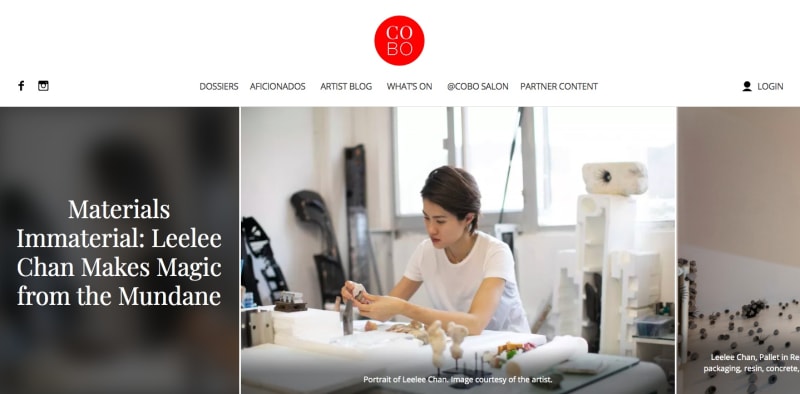Turning trash into treasure is Leelee Chan’s trade, but to describe it as such might suggest she’s some sort of DIY queen. Although she is, in a sense, it may be a reductionist title to give this conceptual artist. Taking found objects from the streets of Hong Kong, Chan reconstructs detritus into sculptures that redefine the source material’s orientation, function, and purpose. Her building blocks are relics of Hong Kong’s extreme urbanity—asphalt from construction sites, cardboard fruit trays, broken umbrellas—but also natural elements such as tree bark. Together, these highlight the paradox inherent in the city’s extreme proximity to nature, as well as explore the tension between accepted contradictions. Through her practice, Chan seeks to subvert traditional paradigms by creating new forms, in an aesthetic that is equal parts kooky and ethereal.
You began your career painting. How did your practice evolve to be predominantly in sculpture?
When I was in graduate school at the Rhode Island School of Design, I struggled with painting. I was using collage elements from magazines: cutting them out; taking them out of context; and rearranging them to compose a painting. But I wanted to break out of this format, because it had limitations. Everything was cut out of magazines, so they were all the same size.
I started to make free-form paper sculpture using those collage elements. I built a whole stage set, and then I photographed it and started painting with that image. And the professor came in and said, “This paper sculpture is way more interesting than the photograph or the painting. Why do you think you need to paint? Maybe you can achieve the things you want without painting.”
I started using different materials, to try to give a more physical presence to the sculpture. I made small sculptures and I thought, what would happen if I made it bigger? What would happen if I made it 20 times bigger? I was making small objects that were very controlled and precious, and it bothered me. Maybe if I made things bigger, there’d be more room for me to fail, for things to fall apart.
After I came back to Hong Kong, every artist or person I talked to tried to give me advice. Maybe you should make a sculpture that can be taken apart. Maybe you should do video art. They tried to help me by giving advice on how to be more self-sufficient and practical. And I think it’s interesting, [because] I’ve come all this way; I’ve practiced to this moment. I want to go all the way with sculpture to see what happens, even in an environment that is not practical at all.
How did you begin incorporating the found objects that are now so integral to your work?
When I first moved back to Hong Kong four years ago, I was in Fo Tan. Every time I went to the studio, I would see some discarded objects on the street. I told myself not to pick them up, but I couldn’t help myself. I walked past the objects many times and I felt like they really wanted me to take them home. And once I started collecting them I just really felt an impulse to make something. And that’s how I started.
The materials you see are like a big [piece of] Styrofoam, industrial-sized because they are used for packaging car bumpers, in unusual colours. I thought they looked like fossils. I always have these strange associations and I always find some human character in these objects. And I thought, it’s maybe something only I can see. But I wanted people to see it as well, so that’s why I wanted to make sculptures, I wanted people to see my visions.
I spend a lot of time looking at the objects, thinking of them, turning them upside down, making them do the wrong thing. Just to forget what you know about the objects, because you always have this perception of what this object’s function is. Like a plastic pallet you see stacked on the street. When you put it upright it opens a lot of possibilities. I think of stained glass windows, and about mechanical machines, where you can see the details inside. I always place objects that are not related to each other together, to see if there’s any interesting connections or contradictions; I’m interested in things that are opposite and in putting them together. Organic versus structured. There are some biomorphic forms in my work that at the same time deal with industrial objects.
The objects you use also appear to have a strong connection to the city, to Hong Kong. What is it about the city—and environments, urban or rural—that influences your work?
Hong Kong is a city that is full of contradictions. You’re so close to nature, literally a 20-minute bus ride, and at the same time, you have extreme urbanisation. Even when you walk down the street, there are a lot of hidden spaces. People try to maximize their space; they have their own DIY solutions. It seems very strange to exist in this kind of urban environment. I don’t know if it makes sense, but I see a lot of contradictions in the city.
I left Hong Kong at age 17 and even then, the place I moved to was really extreme. I lived in Utah, United States. I didn’t speak much English. It was extreme nature and it was frightening. I’d never seen the sky so dark, I’d never experienced such complete silence or being so close to nature. All these contradictions [in my work] come from my experiences living in very extreme places.
You’ve been shortlisted for the BMW Art Journey prize. What would be your intention should you receive the grant, and provided we can soon travel?
I started to imagine myself as an alchemist or an archaeologist, going to places to find out where materials come from. In Hong Kong, we are so detached from how things are made. Everything is ready-made; you just buy it. People are constantly trying to mimic nature in interior design—like marble. We use this element, but we don’t know where it comes from. I want to see how this material is excavated, how people do it.
I think people don’t mention the story [of my materials] because the ones I use are usually mass produced, with no aesthetic value and no memory value. It’s more about how I encountered these objects, not so much how they are made. Recently, I’ve been using materials like marble or stone, with more natural elements, combined with mass-produced industrial products. So I want to find out about the history behind them.
I started to think about minerals because I’m working on a project about Chinese antiques [for a group show] called “Up Close – Hollywood Road,” curated by Hilda Chan and Iven Cheung. It is currently scheduled to open on 30 May. The participating artists are Oscar Chan Yik Long, Lam Tung Pang, Hanison Lau Hok Shing, Bing Lee, and myself. Our works will be displayed among the collections in four antique shops on Hollywood Road.
I have a background in antiques because my parents ran a shop selling them on Hollywood Road. So for this project, I’m working on making sculptures using ceramics from the Song and Ming Dynasties. I’m cutting them into pieces and then using silver to make jewellery. It got me thinking about the long history of ceramics and silver, and how they come from simple things—clay, water, and fire. That [initiated] my curiosity to go and see the places and the people [involved in their production].
Is the process as important to you as the product?
This is where the meaning comes from, and is a big part of my practice. If you take away that process, I don’t think my work has the same meaning. At the same time, when people see my work, I don’t want to give them too much of a burden, like “Oh, she spent a long time working on this part”, or to see the blood behind the work. I want them to think things are just happening, I like that magical moment.
People always feel like they need to read the artist statement. They think [the artwork is] very conceptual and are afraid to say the wrong thing. But I’m happy when people recognise things, like, oh, that’s a pallet. They make their own associations and stories about the objects, and they’re not afraid to say what they see.



